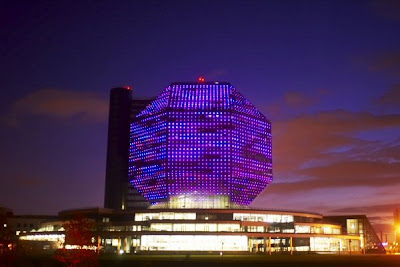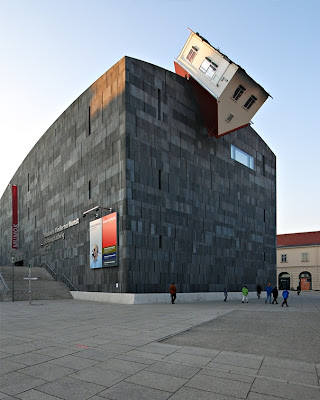15 Living Walls, Vertical Gardens & Sky Farms ecology
A living wall, also referred to as a green wall, vertical garden, or sky farm, is usually part of a building and consists of some sort of vegetation. These types of gardens are sometimes referred to as urban gardening, because they are well-suited for an urban environment where space on the ground is very limited but vertical space is plentiful. These vertical gardens can be quite spectacular in appearance, and in some cases, they even work to filter clean air into the building in which they are growing upon.
Vertical gardens can be grown on just about any type of wall, with or without the use of soil, and they can be placed both on outdoor and indoor walls. As long as there is not shortage of water for the living wall, no soil is required. These amazing sky farms are able to literally bring life to an old rundown building in the middle of the city and they are becoming increasingly popular inside office buildings, homes, and retail stores because of their outstanding beauty and their natural air purification properties.
Living walls have fast become an art form for many people, and one of the pioneering vertical garden artists is Patrick Blanc. He observed how plants were able to grow vertically without the need for soil in the wild, and soon developed a way to create artistic looking vegetation walls that were both lightweight and needed little maintenance. Since these living walls only weighed approximately 30 kg or less per square-meter, he noticed that just about any type of wall would be able to support the weight of a vertical garden. There are many amazing examples of vertical gardens around the world. Here’s our list of some of the most creative and beautiful living walls in the world. We may have missed some of course, but please feel free to drop any we’ve missed in the comments.
Musee du quai Branly, Paris, France
This popular French museum near the Eiffel Tower in Paris is home to one of the best examples of vertical garden work by artist Patrick Blanc. The living wall here is about 200 meters long and 12 meters tall. The museum’s living exterior was at one time healthy and vibrant, but today you can see signs of the inadequate support for irrigation and drainage of the garden – although it still remains breathtakingly beautiful.
Sky Farm, Las Vegas
A proposed $200 million sky farm in the city of Las Vegas would be the world’s first 30-story vertical farm. This building would have 30 floors of indoor farm land, and it is estimated that a vertical farm such as this one could produce enough food to feed 72,000 people per year. This proposed vertical sky farm would grow approximately 100 different crops, and would bring in an estimated $40 million in annual revenue via produce sales and tourism to the one-of-a-kind structure. This sky farm is only in the preliminary stages of design, and it could quite a while before this awesome vertical farm is actually built (if ever).
SkyFarm, Toronto, Canada
A new vertical farm in the downtown area of Toronto, called SkyFarm, could help to feed 35,000 area residents each year. The advantage of the SkyFarm is that the proposed building would only require about 1.32 hectares of land for the 58 story building to sit on. However, it will have about 8 million square-feet of growing space for crops, bringing in the same amount of produce as a 420 hectar farm. The 714 feet structure would bring in an estimated $23 million of revenue each year.
Residence Antilia, Mumbai, India
This new eco-building is scheduled to be completed by the end of 2008, and upon its completion will hold the world record for the largest and tallest living wall, not just in India, but on the planet. This 200 meter tall building, called Residence Antilia, will feature vertical gardens all the way up its exterior walls. Costing, $1 billion, the revolutionary design will make it not only the world’s greenest skyscraper, but also one of the most unique and beautiful structures in the world.
NEXT: See the amazing living wall system in Japan and the spectacular vertical farms of paris
Pages: 1 2 3
15 Living Walls, Vertical Gardens & Sky Farms ecology” />
NEXT: living walls and sculptures of Madrid, Bangkok and Bilbao and the future of vertical gardens.
Parabienta Living Wall System, Japan
This living wall is manufactured and marketed by two Japanese companies that have created a product that is lightweight, cheap, and very functional. The living wall is called ‘Parabienta‘, and it costs approximately $60 per square foot. This eco-friendly wall will significantly cool down a building through a naturally occurring cooling process that takes place within the plants – otherwise known as shade.
Paris, France – A Vertical Garden Mecca
The ‘city of love’ is a sort of vertical garden hotspot, and it’s becoming increasingly popular and mainstream to ‘decorate’ a bland wall with a plethora of beautiful plants, whether it be for artistic purposes or for more functional eco-friendly intentions. Much of the reason that Paris is such a vertical garden mecca is the fact that one of the founding fathers of the art form, Patrick Blanc, lives there. He, and other living wall artists have created some amazing vertical gardens in France’s capital city.
Foundation Cartier
The plant wall at the entrance of the Foundation Cartier has not been trimmed since it was planted back in 1998. The only maintenance of this beautiful garden involves a gardener coming in about every 2-3 months to remove dead leaves, or whole plants, and replace them with new ones.
BHV Homme
The vertical garden at this popular Parisian department store literally adds life to the back of BHV Homme in Paris. This artistic living wall almost resembles an abstract painting from afar.
Pics: 1, 2
Pershing Hall Hotel
Nestled in the courtyard of the Pershing Hall Hotel is a 30 meter high vertical garden that features over 250 different plant species. It’s quite a site, to say the least!
Pics: 1, 2
Club Med Champs-Elysees
The small vertical garden at this Club Med in Paris is designed to represent plants from 5 different continents. The addition of the vertical garden at this Club Med location is all part of a plan to create a more upscale feel for the already first-class resort. The garden is visible from outside and is beautifully lit at night.
Pic: 1
NEXT: living walls and sculptures of Madrid, Bangkok and Bilbao and the future of vertical gardens.
Pages: 1 2 3
15 Living Walls, Vertical Gardens & Sky Farms ecology” />
CaixaForum, Madrid, Spain
As the newest museum in Madrid, CaixaForum certainly takes innovation to the next level before you even walk into the place. One of the exterior walls features a huge 24 meter high vertical garden with over 15,000 plants from more than 250 different species. This artistic display is one of the finest examples of living walls anywhere in Spain.
Pics: 1
Vertical Gardens, Bangkok, Thailand
The vertical gardening phenomenon is spreading like wild fire across the globe, and it’s no different in Bangkok, Thailand. Check out these photos of two great examples of vertical gardening. The first two photos are at the Siam Paragon Shopping Center, and the second is a cool example of how strategically placing plants vertically alongside an elevator shaft at the Emporium Bangkok can add a nice decorative touch.
Pics: 1
Guggenheim Museum, Bilbao, Spain
In front of the Guggenheim Art Museum you’ll find an awesome example of vertical gardening in the depiction of a puppy made entirely out of plants. The artist, Jeff Koons, created this 43-foot tall “plant puppy” in the mid-1990s using a steel substructure and a variety of plants. The detail of this piece is amazing.
Pics: 1, 2
ACROS Fukuoka Prefectural International Hall, Japan
The 100,000 square foot rooftop at the ACROS Fukuoka building is definitely one-of-a-kind. The 18 story building features 15 stepped terraces that can actually be climbed to the top. The terraces are meant to promote a serene and peaceful environment in the middle of the city with lots green plants and even waterfalls and small pools to add to the calming effect of the building’s extraordinary exterior.
Living Walls, Netherlands
This building is a great example of how you can spice up a boring exterior and turn it into a living and breathing wall. The plants are growing in a thin layer of felt and rock wool material instead of soil. Recycled rain water is pumped through this material to provide nutrients to the root systems of the plants.
Pic: 1
Future Vertical Sky Farm Designs
The idea of being able to save valuable space on the ground and to farm vertically has intrigued many designers, architects, and government officials. Sky farming saves space on the ground, can provide a year-round crop, and can be placed in the middle of the busiest cities in the world. With overpopulation, rocketing food prices and the migration to cities, traditional farming could soon become obsolete. This poses an interesting question: could these futuristic and green utopic visions become the standard, the new way to farm in the future?



































































